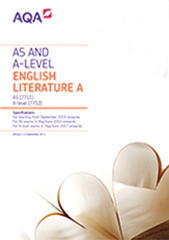Subject content – AS
English Literature A’s historicist approach to the study of literature rests upon reading texts within a shared context. Working from the belief that no text exists in isolation but is the product of the time in which it was produced, English Literature A encourages students to explore the relationships that exist between texts and the contexts within which they are written, received and understood. Studying texts within a shared context enables students to investigate and connect them, drawing out patterns of similarity and difference using a variety of reading strategies and perspectives. English Literature A privileges the process of making autonomous meaning, encouraging students to debate and challenge the interpretations of other readers as they develop their own informed personal responses.
The historicist method of studying texts diachronically (across a very broad time period) is at the centre of the specification. In Love through the ages, the theme of love, one of the most central themes in literature, is explored across time. Given the spirit of the specification, rather than imposing a uniform list of prescribed set texts, various options are offered in terms of both time period and genre.
Working within historicist principles means students are required to read widely across a range of texts. Working with texts over time involves looking at ways in which authors shape meanings within their texts. It also involves thinking about a wide range of relevant contexts, some of them to do with the production of the text at the time of its writing, some (where possible) to do with how the text has been received over time, and most of all in this specification contexts to do with how the text can be interpreted by readers now. And finally, because texts and their meanings are not fixed, interpretation is not fixed, and multiple interpretations are possible.
The specification reflects the belief that the assessment objectives (AOs) work best together, producing a rounded and holistic view of English literature. Thus all five AOs are addressed in each question. See Assessment objectives
When used in AS and A-level English Literature questions, the term ‘significance’ has a very specific use and gives access to AOs 2, 3, 4 and 5. Its use here derives from semiotics and involves understanding the idea of 'signification'. In the way literary study is configured in this specification, significance involves weighing up all the potential contributions to how a text can be analysed: through the way the text is constructed and written; through text specific contexts that can be relevantly applied; through connecting the text(s) to other texts; and then finding potential meanings and interpretations.
Whilst the course invites a variety of written response types, these will all encourage critical debate. In each task, students will be required to argue and to show personal responses and critical preferences, supported by the terminology relevant to the topics and contexts with which they are engaging. In doing so, they will be able to show 'creativity'. English Literature A not only equips students with the knowledge and skills needed for exams, but also opens up a rich, challenging and coherent approach to English literature that provides an excellent basis for further study in the subject.
This specification promotes as wide a choice of texts for you and your students as possible within a clear and helpful framework. The requirement in the subject criteria for students to study a minimum of four texts from particular genres and periods has been organised as follows:
| Love through the ages | |
|---|---|
| One drama text | A Shakespeare play from set list (pre-1900) |
| One poetry text | From set list |
| Two prose texts | From set list |
This specification has been designed to be co-teachable with the AQA English Literature A A-level specification.
